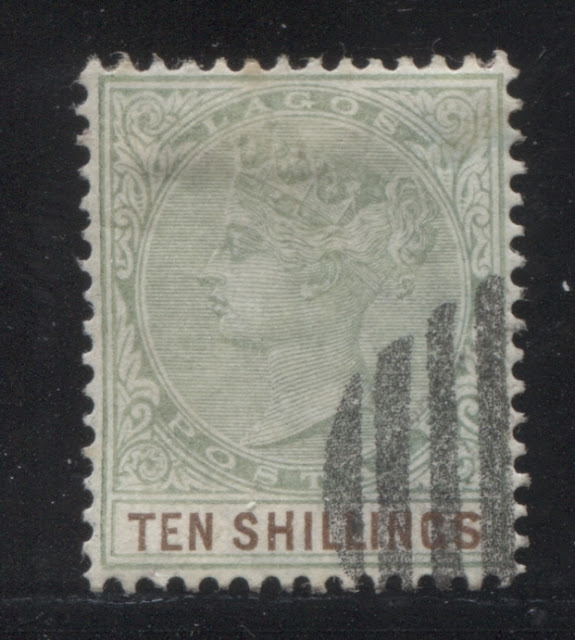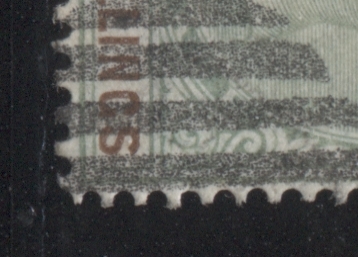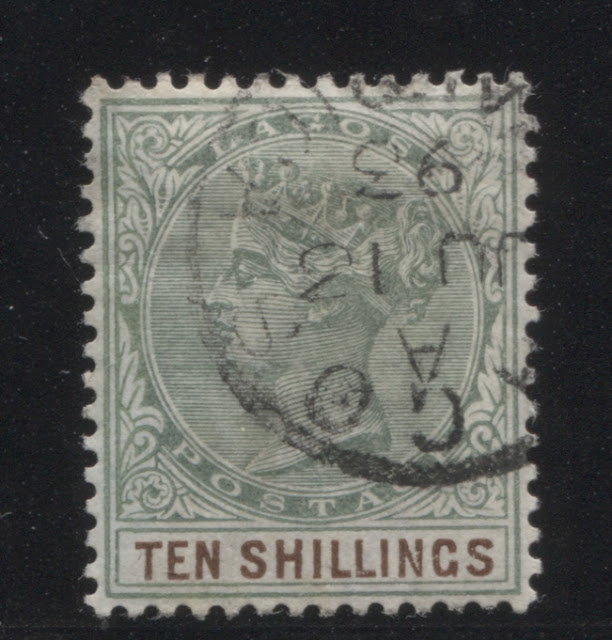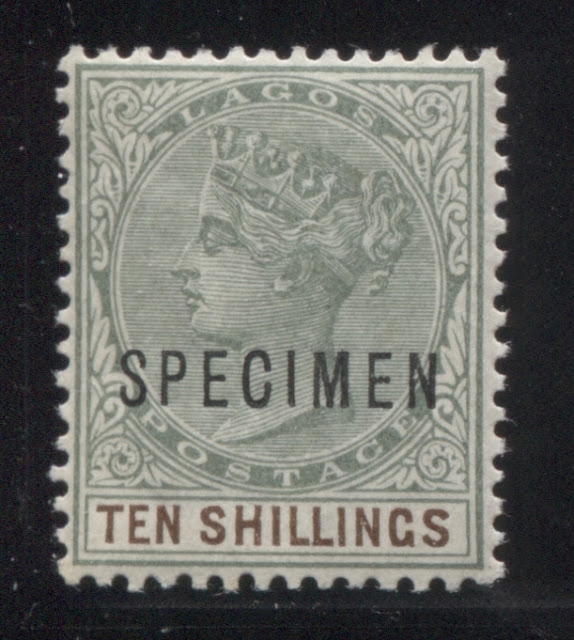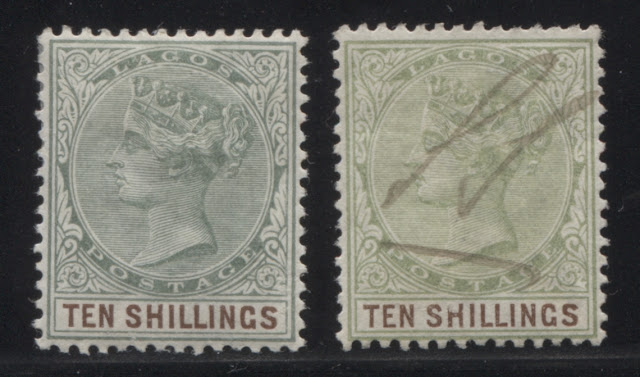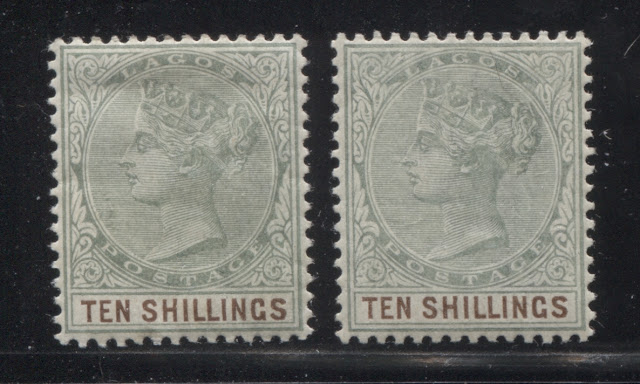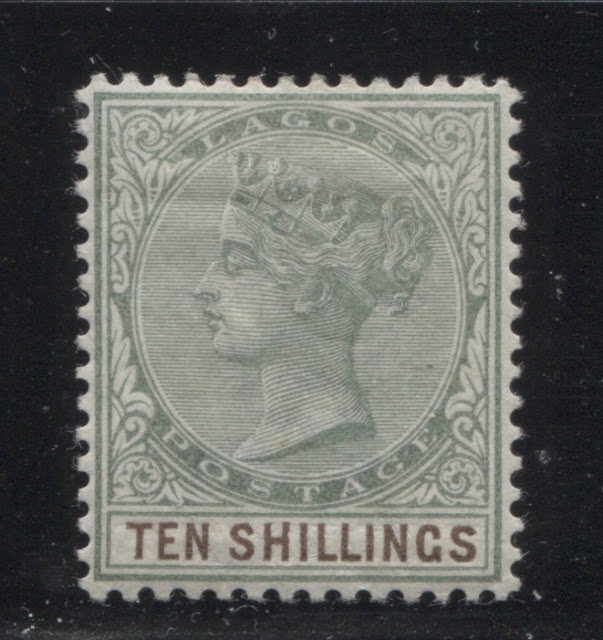This week, I will deal with the last of the high value keyplate stamps from this series: the ten shilling green and brown. This is on a par with both the 2/6d and 5/- in terms of absolute scarcity, but because it is a higher denomination, the standard stamp catalogues ascribe a higher value to it.
According to Ince, the total number of stamps printed and sent to the colony between March 1887 and August 19, 1901 was 24,720, of which 13,620 remainders were sent back to London in 1905 for destruction. This leaves a net issue quantity of 11,100 stamps, which makes it slightly less scarce than the other two high values.
This stamp, being half a pound, would have seen very little postal use indeed, and consequently, genuine used examples are genuine rarities. One has to be very careful of altered halfpenny stamps that have had the words "Half Penny" erased and the new value "Ten Shillings" drawn in. One also has to watch for fake cancellations on mint stamps. I have examples of both, that I unfortunately bought as genuine items originally, that I will illustrate here, just to show you how good the fakery can get.
This is the only high value I have found so far that has a printing from plate 2 that I am able to confirm, on the basis of both the clarity of the printing impression and the fresh and colourless gum that is characteristic of the printings made at the turn of the century. I have printings from states 1 through 3 of plate 1, but I have not, so far seen any from states 4 and 5. This suggests that many fewer printings were made of this value, in larger numbers than was the case with the 2/6d and 5/- stamps.
All told, I have identified 14 printings of this value, which would, if all printings are represented here, be about 1 sending per year between March 1887 and August 1901, and would have amounted to an average of 1,765 stamps per shipment. By the time this stamp was issued, there were at least 11 operating post offices in the colony, if not more, so this would amount to less than 170 stamps per post office, which is not very many. In actual fact, the Lagos GPO would have had a larger allotment than the smaller offices, so that most post offices probably received fewer than 100 stamps.
The actual demand for these was far lower though, judging by the number of late usages and the absolute rarity of used examples, relative to mint. I have found exactly one faded used example with a manuscript cancellation, which suggests to me that even though they were authorized for revenue usage, that very few were authorized for this purpose.
I will now discuss these 14 printings in depth. One of the last printings contains a spectacular partial double print of the duty plate caused by movement of the type, which I had thought might be a faked stamp. But after carefully checking the colour and the stamp surface, I am of the opinion that it is a legitimate variety. Before I get into the specific printings I want to show you two examples of what to be wary of when buying these stamps: the altered 1/2d stamps and fake cancellations.
1/2d Stamp Altered by Erasing the Value and Repainting
As stated in all my earlier posts, the first state of the plate is characterized by nearly all of the fine detail in the hair, jewels and diadem being clearly visible and with little to no merging of the hairlines at the top of the head, and most detail of the hair at the very back of the head visible both above and below the diagonal ribbon.
First Printing
The head plate colour of this printing is very close to Gibbons's deep dull green, but is just a bit deeper. It is not quite deep enough, or grey enough to be the deep grey-green. The duty plate colour is a perfect match to Gibbons's deep brown.
I have one very nice mint example shown above, and one faded used example, which I have ascribed to this printing, due to the fact that the plate details match, as does the duty plate colour. The cancellation is somewhat of a mystery, as it does not appear to be one of the regular Lagos barred oval obliterators. However, it could be an example of the 10-bar ovals that were in use in Ibadan.
Second Printing
The head plate colour of this printing is closest to Gibbons's grey-green, but is paler. The duty plate colour is very close to Gibbons's blackish brown.
Group 2 - Printings 3-7, From the Second State of the Plate - 1890 to 1894
In the second state of the plate, the detail is similar to the first state, except that there is a slight loss of sharpness to the detail and the beginning of some merging of the hairlines, though very, very little.
Third Printing
Fourth Printing
Fifth Printing
The head plate colour of this printing is closest to Gibbons's grey green, but is quite a bit paler. It is not bluish enough to be the dull blue green however. The duty plate colour is closest to Gibbons's sepia shade.
I have three mint examples and one nice used example as shown above. The used stamp is very slightly faded, but still has about 85-90% of its original colour, which is pretty good for a used stamp of this nature. It is cancelled with a nice strike of a 24 mm Lagos CDS, dated February 2, 1899.
Seventh Printing
The head plate colour of this printing is closest to Gibbons's deep dull green, but there is a hint of blue to the colour. There is not enough though to make it a match to the deep blue green. The colour is actually a blend of the deep dull green and the deep blue green. The duty plate colour is very deep brown.
I have the very nice mint example shown above, and what appears to be a fiscally used example with a manuscript cancel. It is quite severely affected by water, as the colour is bright yellow green. I have assigned it to this printing because the duty plate colour matches the other stamp, and it is from the third state of the plate.
Tenth Printing
The head plate colour of this printing is very similar to the seventh printing in that it is a pale version of Gibbons's grey green. The duty plate colour is deep sepia.
I have two very nice mint examples, the second of which is never hinged, and two nice used examples. The first one is canceled with a 24 mm Lagos CDS, dated February 22, but I cannot read the year. The other example is cancelled with a somewhat weak strike of a Lagos 8-bar oval obliterator.
Eleventh Printing
The head plate colour of this printing is closest to Gibbons's dull blue-green, being an almost perfect match. The duty plate colour is deep sepia.
Twelfth Printing
The head plate colour of this printing is definitely dull, but it lacks the bluish undertone required for the dull blue green. At the same time, it is much paler than Gibbons's deep dull green, but deeper than Gibbons's dull green. I would therefore call it the deeper dull green, which denotes that it is not as deep as the deep dull green. The duty plate colour of this printing is also deep sepia.
Thirteenth Printing
If you look carefully, you can see that the "E" had been struck twice and the "T" is crooked relative to "E".
Fourteenth Printing, From Plate 2 - 1901-1903
This printing has been identified as being from plate 2 on account of the complete lack of plate wear in the design, and the fact that the gum and paper are consistent with other printings made, of other denominations around this time. All of the finer detail is completely visible, in the hair, the crown and the medallion, which is only possible at this time for printings made from a new plate, as plate 1 was so worn by 1900 that most of the finer detail in the design is obscured.
According to Ince, the total number of stamps printed and sent to the colony between March 1887 and August 19, 1901 was 24,720, of which 13,620 remainders were sent back to London in 1905 for destruction. This leaves a net issue quantity of 11,100 stamps, which makes it slightly less scarce than the other two high values.
This stamp, being half a pound, would have seen very little postal use indeed, and consequently, genuine used examples are genuine rarities. One has to be very careful of altered halfpenny stamps that have had the words "Half Penny" erased and the new value "Ten Shillings" drawn in. One also has to watch for fake cancellations on mint stamps. I have examples of both, that I unfortunately bought as genuine items originally, that I will illustrate here, just to show you how good the fakery can get.
This is the only high value I have found so far that has a printing from plate 2 that I am able to confirm, on the basis of both the clarity of the printing impression and the fresh and colourless gum that is characteristic of the printings made at the turn of the century. I have printings from states 1 through 3 of plate 1, but I have not, so far seen any from states 4 and 5. This suggests that many fewer printings were made of this value, in larger numbers than was the case with the 2/6d and 5/- stamps.
All told, I have identified 14 printings of this value, which would, if all printings are represented here, be about 1 sending per year between March 1887 and August 1901, and would have amounted to an average of 1,765 stamps per shipment. By the time this stamp was issued, there were at least 11 operating post offices in the colony, if not more, so this would amount to less than 170 stamps per post office, which is not very many. In actual fact, the Lagos GPO would have had a larger allotment than the smaller offices, so that most post offices probably received fewer than 100 stamps.
The actual demand for these was far lower though, judging by the number of late usages and the absolute rarity of used examples, relative to mint. I have found exactly one faded used example with a manuscript cancellation, which suggests to me that even though they were authorized for revenue usage, that very few were authorized for this purpose.
I will now discuss these 14 printings in depth. One of the last printings contains a spectacular partial double print of the duty plate caused by movement of the type, which I had thought might be a faked stamp. But after carefully checking the colour and the stamp surface, I am of the opinion that it is a legitimate variety. Before I get into the specific printings I want to show you two examples of what to be wary of when buying these stamps: the altered 1/2d stamps and fake cancellations.
1/2d Stamp Altered by Erasing the Value and Repainting
I bought the above stamp several years ago as a genuine 10s stamp with a nice Lagos barred oval cancellation. At the time, I was unfamiliar with the shades of green used on these stamps, and I was not aware that altered low values existed. However, eventually something about it looked off: the green was much too dark and dull to be one of the high value stamps. It looked a lot to me like one of the earlier printings of the half-penny. Then the value tablet looked as though it had been erased: the surface of the paper was rough, when the keyplate stamps are normally smooth. This suggested to me the possibility of an eraser being used to erase the original words "Half Penny". The words "Ten Shillings" would then be painted in very carefully, using a brown ink of approximately the same tone and depth.
Here is a close-up of the value tablet:
If you look carefully, the letters look both thin, and somewhat fuzzy, whereas the lettering on genuine stamps is always clear and sharp. The white around the value tablet looks somewhat rough, dirty and smeared, which are the tell-tale signs of an expert erasing job. It is a very well executed fake that would fool 99% of collectors, who do not know what to look for.
Genuine Stamp With Forged Postmark
This stamp is a somewhat faded, genuine stamp from what is likely the first printing, that has had a fake oval grid postmark applied by a laser printer. The dead giveaway is the fact that the cancellation is made up of thousands of tiny dots, whereas the genuine cancellation is solid and you can never see the design very clearly through the parts of the design that have been cancelled with the solid bars. Here, you can see nearly all of the design details that are lying underneath the cancel, as well as the dotted nature of the cancellation.
In case you cannot see the dots clearly, here is a rotated close-up scan:
Here you can see that the cancellation is made up of tiny dots, and is way too "perfect" to be a genuine barred oval obliterator. It was likely applied in order to take a faded, mint no gum stamp and turn it into the more desirable and valuable used example.
Group 1 - Printings 1-2, From the First State of the Plate - March 1887 to approximately 1890
As stated in all my earlier posts, the first state of the plate is characterized by nearly all of the fine detail in the hair, jewels and diadem being clearly visible and with little to no merging of the hairlines at the top of the head, and most detail of the hair at the very back of the head visible both above and below the diagonal ribbon.
First Printing
The head plate colour of this printing is very close to Gibbons's deep dull green, but is just a bit deeper. It is not quite deep enough, or grey enough to be the deep grey-green. The duty plate colour is a perfect match to Gibbons's deep brown.
I have one very nice mint example shown above, and one faded used example, which I have ascribed to this printing, due to the fact that the plate details match, as does the duty plate colour. The cancellation is somewhat of a mystery, as it does not appear to be one of the regular Lagos barred oval obliterators. However, it could be an example of the 10-bar ovals that were in use in Ibadan.
Second Printing
The head plate colour of this printing is closest to Gibbons's grey-green, but is paler. The duty plate colour is very close to Gibbons's blackish brown.
Group 2 - Printings 3-7, From the Second State of the Plate - 1890 to 1894
In the second state of the plate, the detail is similar to the first state, except that there is a slight loss of sharpness to the detail and the beginning of some merging of the hairlines, though very, very little.
Third Printing
The head plate colour of this printing is an almost perfect match to Gibbons's deep dull green. The duty plate colour is a match to Gibbons's deep brown.
The above mint example has been very carefully cut out of a sheet with scissors, as can be seen by the of the perforations on three sides. It is not re-perforated, as the perforations on all four sides gauge exactly 14, as they should. This would not be the case if the stamp was re-perforated.
Fourth Printing
The head plate colour of this printing is closest to Gibbons's dull blue green, but a bit deeper. The duty plate colour is blackish brown.
This mint example with specimen overprint shows an interesting variety of the overprint, which may or may not be constant. The variety consists of a dot in the bottom loop of the "S".
Fifth Printing
The head plate colour of this printing is closest to Gibbons's deep blue green, but is just a touch duller. It does have the vibrant bluish undertone, though, that none of the other printings really have, and this does not appear to have resulted from exposure to water. The duty plate colour is deeper than Gibbons's deep brown, but not as deep as the blackish brown. So I would call this shade the very deep brown.
This is a very nice used example, which has been cancelled by a 21 mm Lagos CDS, dated June 13, 1893. There is a very small area of thinning at the top left corner, which does not show through to the front and is not very severe. To date, this is the only 21 mm CDS cancel that I have seen on a 10 shilling stamp. So it is philatelically significant, regardless of whether or not it has a small thin.
Sixth Printing
The head plate colour of this printing is closest to Gibbons's grey green, but is quite a bit paler. It is not bluish enough to be the dull blue green however. The duty plate colour is closest to Gibbons's sepia shade.
I have three mint examples and one nice used example as shown above. The used stamp is very slightly faded, but still has about 85-90% of its original colour, which is pretty good for a used stamp of this nature. It is cancelled with a nice strike of a 24 mm Lagos CDS, dated February 2, 1899.
Seventh Printing
The head plate colour of this printing is closest to Gibbons's grey green, being an almost exact match. The head plate colour is closest to Gibbons sepia shade, but is darker. It doesn't contain enough black to be the blackish brown.
Group 3 - Printings 8-13, From the Third State of the Plate 1895-1900
As stated many times in other posts, the third state of the plate is characterized by a lack of detail in the hair at the back of the head, especially the hair above the diagonal ribbon. There is also merging of the top three to five hairlines at the top of the head.
Eighth Printing
The head plate colour of this printing is a perfect match to Gibbons's dull blue green. The duty plate colour is blackish brown.
This fantastic mint example with "specimen" overprint is also never hinged, which is unbelievably rare for a specimen overprint. To begin with, there are probably no more than 300-400 of these printed, and most of these were stuck down in sample books. So most specimens either have no gum or severely disturbed gum. To find one with pristine gum, from this period, is unheard of.
Ninth Printing
The head plate colour of this printing is closest to Gibbons's deep dull green, but there is a hint of blue to the colour. There is not enough though to make it a match to the deep blue green. The colour is actually a blend of the deep dull green and the deep blue green. The duty plate colour is very deep brown.
I have the very nice mint example shown above, and what appears to be a fiscally used example with a manuscript cancel. It is quite severely affected by water, as the colour is bright yellow green. I have assigned it to this printing because the duty plate colour matches the other stamp, and it is from the third state of the plate.
Tenth Printing
The head plate colour of this printing is very similar to the seventh printing in that it is a pale version of Gibbons's grey green. The duty plate colour is deep sepia.
I have two very nice mint examples, the second of which is never hinged, and two nice used examples. The first one is canceled with a 24 mm Lagos CDS, dated February 22, but I cannot read the year. The other example is cancelled with a somewhat weak strike of a Lagos 8-bar oval obliterator.
Eleventh Printing
The head plate colour of this printing is closest to Gibbons's dull blue-green, being an almost perfect match. The duty plate colour is deep sepia.
Twelfth Printing
The head plate colour of this printing is definitely dull, but it lacks the bluish undertone required for the dull blue green. At the same time, it is much paler than Gibbons's deep dull green, but deeper than Gibbons's dull green. I would therefore call it the deeper dull green, which denotes that it is not as deep as the deep dull green. The duty plate colour of this printing is also deep sepia.
Thirteenth Printing
The head plate colout of this printing is closest to Gibbons dull blue green, but a little deeper, so it is consistent with the shades normally found on this stamp. The duty plate colour is deep reddish brown, which is very distinct from the other printings.
This superb used example is cancelled with a very clear strike of a November 15, 1901 Lagos CDS measuring 24 mm wide. At first I thought this might be an altered stamp. But after carefully examining it I have come to the conclusion that it is genuine. There is no roughening of the paper around the value that would occur if the value tablet had been erased. The colour is consistent with the other 10 shilling stamps.
What I do believe is that there was a problem that occurred with the typeface during printing, in which it slipped, resulting in some partial double printing, as shown in the close-up scan below:
If you look carefully, you can see that the "E" had been struck twice and the "T" is crooked relative to "E".
Fourteenth Printing, From Plate 2 - 1901-1903
This printing has been identified as being from plate 2 on account of the complete lack of plate wear in the design, and the fact that the gum and paper are consistent with other printings made, of other denominations around this time. All of the finer detail is completely visible, in the hair, the crown and the medallion, which is only possible at this time for printings made from a new plate, as plate 1 was so worn by 1900 that most of the finer detail in the design is obscured.
The head plate colour of this last printing is closest to Gibbons's dull blue green, but is just a touch brighter. The duty plate colour is blackish brown.
I have one sole mint example of this very rare printing. It will have been very rare because nearly all of this printing will have been included in the unsold remainders that were sent back to London for destruction in 1905. There are likely only a handful of these in existence today.
So this concludes my discussion of this scarce high value, and brings me to the point where I am ready to go back and tackle the two most difficult values of this series, being the 1/2d green and 1d carmine. I've already looked at the printings made between 1884, when these values first appeared and the end of 1886. There were over 40 more printings of each value made between 1887 and 1901, and it is these that I intend to identify using all the information I have learned in the course of examining the other values of this series.




